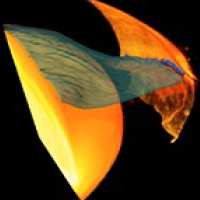Detecting cortical bone microcracking in impact loaded human tibae
Chris Westgate (MSc student), supervised by Dr Angelo Karunaratneoshua
 High strain rate axial loading causes macroscopic injuries within localised anatomical zones. There is no structural or mechanical analysis on their effect on skeletal structures proximal to the fracture. Hypothesis
High strain rate axial loading causes macroscopic injuries within localised anatomical zones. There is no structural or mechanical analysis on their effect on skeletal structures proximal to the fracture. Hypothesis
A stress wave transmitted proximally would cause macroscopic and microscopic damage (see image to the right). There will also be a reduction in fracture toughness of the bone, which leads to less stable skeletal fixation.
Objectives
 The project studies load transformation through bone tissue from impact to proximal and their effect on future clinical intervention.
The project studies load transformation through bone tissue from impact to proximal and their effect on future clinical intervention.
The image below shows the outcome of the project, including non impacted, seated and standing/neutral samples. IT also shows the Fuchsin stained images and the 3D rendering of them.
Top row: Bands of arc-shaped circumferential micro damage and diffuse micro damage accumulation. Bottom row: Micro damage accumulation along the length of the specimen.
Validation of live animal imaging of reporter genes in skull, using the Histocutter to image long bones
Dr Cristina Lo Celso and Dr Edwin D Hawkins
Murine tibia with GFP-labelled osteoblasts (green) imaged on Histocutter and reconstructed in Amira.
Jiang Tang (PhD student), supervised by Dr Simon Schultz
The group characterise visual responses quantitatively in mouse lateral geniculate nucleus (LGN), looking into whether these properties are state-dependent and modulated by feedback from visual cortex.
They do electrophysiological research followed by histological processing of tissue and computational methods for neural data processing.
For experiments with successful penetrations, small electrolytic lesions will be generated at the end of recording.
With the Histocutter, they are able to locate these lesions very precisely, which makes it possible to reconstruct electrode tracks and localize recorded units.
Dr Darryl Overby and Dr Alexandra Boussommier-Calleja
Research area: Mechanism of intaocular pressure (IOP) regulation in relation to glaucoma.
Glaucoma is associated with elevated IOP caused by increased outflow resistance of aqueous humour from the anterior chamber of the eye
Primary outflow pathway: Fluid flow from the anterior chamber of the eye to the collector channels, via Schlemm's canal.
The Histocutter was used to look at the 3D architecture of the eye, and in particular the relationship between posterior iris bowing and the dimensions of Schlemm's canal and the trabecular outflow pathway.
 As the iris bows backwards, it applies tension to the outflow pathway, pulling open Schlemm's canal and leading to an artificial decrease in outflow resistance.
As the iris bows backwards, it applies tension to the outflow pathway, pulling open Schlemm's canal and leading to an artificial decrease in outflow resistance.
 By eliminating the pressure gradient across the iris, iris bowing is eliminated, along with effects on outflow resistance.
By eliminating the pressure gradient across the iris, iris bowing is eliminated, along with effects on outflow resistance.
re gradient across the iris, iris bowing is eliminated, along with effects on outflow resistance.